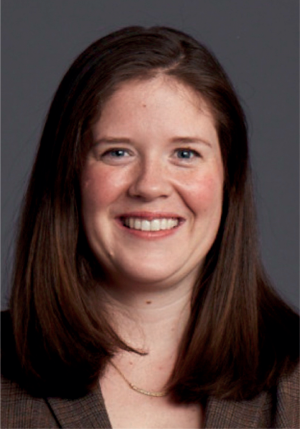Dr Kelly Ruggles, associate professor at New York University Langone Health, discusses with Nature Computational Science how she uses computational approaches to gain insights into cancer, inflammation and cardiovascular disease, as well as the importance of mentorship.

Credit: Courtesy of NYU Langone Health
What has your career trajectory been like?
I have taken a somewhat circuitous path to reach my current position. I have always loved mathematics and because of that decided to pursue an undergraduate degree in biological engineering. After graduating, I was drawn towards more traditional biochemistry and biology, which led me to my graduate work in nutritional and metabolic biology. Both my masters and doctorate research focused on understanding the impact of lipid deposition in non-adipose tissue and how that contributes to metabolic disease. Since I enjoy biology and mathematics equally, my goal was to find a career path that would help me to stay active in both fields. I did a postdoc with Professor David Fenyö, whose work is focused on computational proteomics, where I experienced an ideal combination of my scientific interests. This experience also highlighted the importance of collaboration in research and I have taken what I learned during my postdoc as a model for my own laboratory, where nearly all of our projects rely on close collaborations with experimental biologists and physician scientists.
Speaking of this, what are the challenges of integrating computational and experimental research?
There is often a lack of communication between experimental researchers and computational researchers. On the one hand, computational researchers don’t always recognize that experimental work is arduous and that there are many variables outside the control of an experimental researcher. On the other hand, experimental researchers often feel that computational results should be obtained and shared instantaneously, not acknowledging that computational work also requires multiple iterations and methods to obtain the most accurate and illuminating results.
Could you describe your research to develop methods of analyzing multiomics data for characterizing ischemic heart disease?
This work is being done in collaboration with multiple cardiovascular researchers at NYU Grossman School of Medicine and is part of the ISCHEMIA clinical trial, which focused on evaluating therapeutic approaches to ischemic heart disease. As part of this trial, whole blood was collected from over a thousand people with ischemic heart disease to create a biorepository with extensive clinical and demographic metadata. We now have access to whole-blood RNA-sequencing, methylation, proteomics, metabolomics and genomics data from these thousand or so people. This presents us with an incredible opportunity to evaluate and characterize the molecular landscape of cardiovascular disease and to identify molecular features associated with disease pathology and risk. Our primary goal from these studies is to identify clinical and blood-based biomarkers that accurately predict heart attacks and cardiovascular-associated death risk.
You have also worked in the field of cancer proteogenomics, correct?
This was my primary work during my postdoc, where I worked on elucidating proteomic and genomic drivers of cancer. This work was done as part of the Clinical Proteomic Tumor Analysis Consortium (CPTAC) and has continued in my own laboratory. To gain a deeper understanding of the mechanisms driving tumor biology and metastasis, we develop and apply a number of computational tools to evaluate and integrate tumor proteomics and genomics data. Of all the available data types, I am most excited about the promise of phosphoproteomics data in pushing forward cancer discovery. Getting an unbiased view of phosphoproteomics and signaling in a tumor is particularly informative, because many of the current therapeutics being used to treat cancer are based on kinase and signaling cascade inhibition. As a part of these studies, we developed an outlier analysis tool called BlackSheep (L. Blumenberg et al. J. Proteome Res. 20, 3767–3773; 2021), which identifies aberrant phosphorylation expression associated with disease subtypes of interest.
You are currently serving as the Director of Integrated Sciences for the NYU Grossman School of Medicine Office of Medical Education, and previously, you served as the Director of Academic Programs for the Vilcek Institute of Graduate Biomedical Sciences. What has been your experience working in these positions?
It has been extremely rewarding to work in these education leadership roles and I have always been very passionate about student mentoring. In addition to feeling personally rewarded by the experience of mentoring students, I also feel a sense of responsibility for mentoring because I attribute much of my own success to great mentors that I have had throughout my career. Currently, one initiative at the Office of Medical Education is to increase the exposure of our medical students to computational and technologically innovative biomedical research. We hope that these initiatives will train the next generation of data-literate clinicians and keep our trainees at the leading edge of biomedical discovery.
What would be your advice to young researchers on how to navigate through academia and research as an LGBTQIA researcher?
I would again emphasize mentorship. It is important to find people who understand you both as a scientist and as a human being and to learn from them how to navigate a system that can sometimes feel complicated and impenetrable. Once you are more established, you can then pay it forward by fostering a welcoming and open environment for junior trainees. I try to be very open about my queerness and the various challenges I’ve faced during my career, and I hope that that helps my students to be more comfortable with sharing their identities and experiences. I do feel that we’ve made substantial progress in the last ten years: there are many more open conversations, available resources and communities that foster a more inclusive environment.
Author information
Authors and Affiliations
Corresponding author
Rights and permissions
Reprints and permissions
About this article
Cite this article
Rastogi, A. Integrating computational and experimental worlds.
Nat Comput Sci (2024). https://doi.org/10.1038/s43588-024-00649-w
-
Published: 03 June 2024
-
DOI: https://doi.org/10.1038/s43588-024-00649-w
